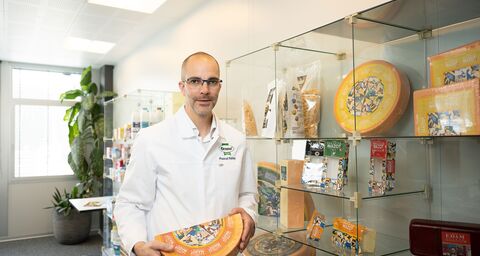
Customer Relationship Management: Customer retention as a competitive advantage
Faced with saturated markets and fierce competition, start-ups and SMEs don’t always have an easy time of winning and holding on to potential new customers. What’s a small company to do? Build solid Customer Relationship Management! We’ll take a look at exactly what CRM is and what options are available. And we’ll talk with two SMEs who share their experiences.
What is CRM?
Customer Relationship Management (CRM) refers to all strategic and operational measures for the systematic design and maintenance of customer relationships. Companies use CRM systems to efficiently record, analyze and evaluate customer interactions. The right software enables for smooth implementation and a targeted alignment of sales and marketing activities as well as the development of sustainable customer relationships.
Why does CRM make sense for companies?
Whether you are a retailer or service provider, SMEs have to compete with both larger companies and aspiring new rivals. Dr. Urs Fueglistaller at the Swiss Institute of Small Business and Entrepreneurship at the University of St. Gallen sums it up as follows: “SMEs are worn down on three fronts: by large, global players with their market power, e-commerce in its various forms and small, agile start-ups.” At the Institute in St. Gallen, Dr. Fueglistaller deals exclusively with SMEs and has followed numerous companies over the past few decades.
Start-ups often have two advantages over SMEs: their innovative approaches and their high degree of digitalization. However, they often have only a limited budget and – unlike already established companies – less experience, visibility (social media) and internal know-how. But like SMEs, they often find it difficult to keep up with and set themselves apart from all the competition.
Good Customer Relationship Management enables start-ups and SMEs alike to build long-term customer relationships with potential new customers. If you put a lot of work into CRM right from the start, it will pay off in the long run. Can’t find the time right now? Then check to see whether you can save resources elsewhere, such as with insurance.
What are the tasks of CRM?
Customer Relationship Management (CRM) includes key tasks such as systematic customer acquisition, retention and reacquisition. CRM supports the targeted management of marketing and service activities and ensures structured support along the entire customer lifecycle. For SMEs in particular, a well-organized CRM is crucial in order to build long-term customer relationships with limited resources and secure competitive advantages.
Customer Relationship Management for small businesses – is it worth it?
Many mid to large-sized companies set great store by Customer Relationship Management and invest heavily in cultivating relationships. Apart from time, start-ups and SMEs may also lack the necessary know-how and data basis.
What is Customer Relationship Management?
Customer Relationship Management (CRM) includes the planning, management and optimization of all interactions with business partners. It is the holistic care of customer relationships.
However, especially in highly competitive markets, Customer Relationship Management is an important pillar that is also worthwhile for start-ups and small companies. Today’s digital tools and leading-edge CRM systems make it possible for even small companies to realize a big impact – and to do it extremely efficiently.
This is why we are exploring the question: What makes good Customer Relationship Management?
“With good Customer Relationship Management in place, companies can take care of their customers as locally and competently as possible so they can continue to grow their customer relationships.”
Know the value of a good customer experience
Evaluate how you reach your customers so you can use the proper channels. In order to optimally nurture relationships with your clients, you need to go where they are and reach out to them. Put yourself in their position and ask yourself: “What do my customers want? How can I help them and how can I let them know I want to help them?” To do this, you need a strategy and possibly some tools that help you make your CRM more efficient. The basis for a successful CRM is to collect and analyze customer data. CRM tools give you lots of options – from personalized consultations to automated mailings.
Please note: If you do use CRM tools, you need to instruct your employees carefully on how to use them. Everyone in your team should know precisely how to enter data and maintain files. Good collaboration ensures high data quality here, which can save you a lot of trouble.
Don’t neglect traditional Relationship Management
Do not underestimate the more traditional forms of relationship management because they can have a big impact as well. Depending on the target group, a personal call is much more effective than an automated email. And this is exactly the point – you should know your target groups and attend to their specific needs. This way, even as a smaller company you can be a player and create a competitive advantage. Ideally, you should combine new digital solutions with traditional tactics that have typically worked for you. As an example, you could enter in your database which clients prefer which channels and include a summary of past conversations.
Ask for feedback
Regardless of which channels you use to manage your customer relationships, it is important to ask your customers for feedback on a regular basis and to learn from it. Only this way will you be able to optimize your CRM and get the best out of your Relationship Management.
Examples of successful Customer Relationship Management
Still undecided? Here are examples of two Swiss companies that show how you and your SME can also use Customer Relationship Management to your advantage.
HiFi SHOP: Focus on advisory and expertise
In a particularly competitive market, Ali Özkul opened his HiFi SHOP in the industrial zone of Pfäffikon in 1997. At that time, there was no sign of the upheaval that the home electronics market was soon to face. At first, the big players like Media Markt emerged on the scene and drove down prices. Later it became just a part of normal life to buy a TV set or kitchen mixer online.
But the HiFi SHOP is still there. “We focus on quality, advice and our expertise,” explains owner Ali Özkul. “We just offer those appliances that we can stand behind, rather than the entire range.” Only stocking three versions of the same appliance at different price points and quality levels is enough for customers and means they don't get overwhelmed like when shopping at the major retailers. “The most important thing is to give customers honest advice and to listen to their wishes,” he adds. “This way I can make them a good offer on what they really want.”
Özkul delivers the purchased appliance to the customer’s house, installs it and provides a five-year warranty. The HiFi SHOP targets consumers from around the country, but his marketing focuses on the regional market in the Zurich Oberland. He advertises in the local papers and sponsors sports clubs from the region. “As a small business, you constantly have to adapt, remain agile and react to changing trends,” summarizes Özkul.
Ali Özkul, HiFi SHOP AG
The HiFi SHOP owned by Ali Özkul in Pfäffikon, canton of Zurich, offers the entire range of home appliances, from TV sets to toasters. Özkul has three employees. He focuses on advising customers in the store, but is also currently setting up an online shop.
YellowKorner: Talk to your customers in person
Gallery owner Caroline Taskin is a firm believer in the personal approach. She owns a YellowKorner franchise, a global gallery for art photographs headquartered in Paris. The company sells high quality photographs in numbered and limited editions. The photos are produced in-house, but can also be purchased online with home delivery. Caroline Taskin runs the franchise, which is one of about 100 YellowKorner galleries worldwide. “Here the clients are able to look at the various formats and versions of the photos and receive help and advice,” she explains. “And of course we have walk-in customers.”
Taskin’s problem is that online customers deal exclusively with the main office in Paris. In order to acquire her own clients, she has to get creative. “I regularly hold gallery viewings, host small cultural events and send out a local newsletter,” says Taskin. “This way, I can expand my customer data and contact customers directly when the opportunity arises.”
In her database, she records not only purchases, but also clients’ preferences for subjects or specific photographs. If a suitable photograph becomes available, she then contacts the client personally. Her customers, both private individuals and business clients, really appreciate this personal touch. “The only tedious part is that this database and knowledge is tied to me and that it is entered in a relatively rudimentary list,” she explains. “Automating this process would, of course, be a major help.”
YellowKorner
YellowKorner is a global company that sells high-quality art photographs in numbered and limited editions. The collections are continually updated. Caroline Taskin, who is actually an economist by trade, runs the gallery franchise in Basel. She regularly holds gallery viewings and cultural events for her local clients. She has two employees.
“Rather than focusing on customer loyalty, SMEs should focus on their customers’ needs.”
The heart of CRM: customer focus
As far as customer loyalty goes, Ali Özkul and Caroline Taskin have done a lot of things right, says Dr. Fueglistaller, but he takes issue with the term itself. “Rather than focusing on customer loyalty, SMEs should focus on their customers’ needs.” Fueglistaller divides this customer focus into three types: forward-facing, aesthetic and learning customer orientation.
When it comes to forward-facing orientation, the focus is on the customer. The company must know what its customers want and must address its customers’ needs. “An SME needs a clear stance – one that sincerely communicates, ‘We are happy to have each one of our customers,’” states Fueglistaller.
If your customer focus is based on aesthetics, the product or service must speak to the person and have a recognition value – one that appeals to the senses as well. This includes language, image and customer interaction. Dr. Fueglistaller knows that “Customers want to experience a sensory appreciation and feel attachment to the product.”
Ultimately, this means a type of customer focus that learns and evolves, something that will likely only gain in importance in the future. Start-ups and SMEs must gather their experiences dealing with customers and put them to use. “A company has to go through learning phases in order to evolve,” explains Dr. Fueglistaller. Otherwise it will be threatened by stagnancy. “Many premium product providers have sat on their laurels in the past and missed the boat.”
According to Fueglistaller, the third of the three basic components is traditional CRM tools. This component involves recording not only sales, but also customer wishes and interests so they can be contacted directly, if necessary. But these tools are only a supplementary measure, he says. “All three of these components are equally important. I multiply each component by the other two. If one is ignored, the other two are of no use, and the result is zero.”
Urs Fueglistaller, SME at USG
The Swiss Institute for SMEs and Entrepreneurship at the University of St. Gallen (HSG) was founded in 1946 and is the only institute in Switzerland dedicated exclusively to SME research. Dr. Urs Fueglistaller is the Director of the Institute and a Professor of Business Management.
How does a CRM system work?
Considering the importance of goal-oriented Customer Relationship Management, the question arises of how companies can effectively implement their CRM strategy. A key component of the implementation of a successful CRM concept is the implementation of a suitable CRM system. Such a system serves as a technological basis for managing, analyzing and optimizing customer relationships.
A CRM system collects, stores and structures customer data centrally. It combines information from sales, marketing and service to provide a coherent view of the customer. Automation helps to design processes efficiently and manage customer relationships in a targeted manner. By automating repetitive tasks such as sending follow-up emails or documenting customer interactions, employees can use their time more efficiently and focus more on customer-centric activities.
CRM provides comprehensive analyses and reports as an analytical tool. This allows companies to measure the success of their customer loyalty measures, identify weaknesses and make informed decisions to further develop their CRM strategy.
Overall, the CRM system is an indispensable tool for effectively pursuing the objectives of Customer Relationship Management and building long-term, profitable customer relationships.
What is the difference between CRM and ERP?
Customer Relationship Management (CRM) and Enterprise Resource Planning (ERP) are both key software solutions in enterprises, but they serve different purposes. A CRM system focuses on building and maintaining customer relationships through sales management, marketing automation and customer service, for instance. An ERP system, on the other hand, controls internal business processes such as accounting, inventory management, purchasing and production. While CRM focuses on the customer, ERP focuses on the optimization of operational processes. Both systems complement each other ideally, especially in growing companies.
How is goal-oriented Customer Relationship Management set up?
Are you looking to establish sustainable Customer Relationship Management at your company? Our step-by-step guide will help you with strategy, implementation and analyses, through to optimization.
Step 1: Define your goals
First you should define your objectives: What should successful Customer Relationship Management do for your company?
Step 2: Analyze the target group
Next you should analyze your target group to find out exactly who your clients are and what needs they have. Only in this way can you ensure targeted customer focus.
Step 3: Market positioning
When you know what the needs of your target group are, then you can position yourself accordingly. Know what your unique selling propositions are and find the added value that you can offer your customers.
Step 4: Develop your strategy
Next you should define your strategy. How do you intend to offer your clients added value? What image do you intend to convey to your target group in your sales, marketing and customer service and how will you cultivate customer relations? What will you do with the data you gather? Your strategy should also include whether you want to use tools for implementation, and if so which ones.
Our tip: Talk to other entrepreneurs in your industry. What works well? What are typical obstacles?
Step 5: Apply CRM
Now it gets exciting because this is the implementation stage. The strategy you defined in Step 4 will serve as a starting point for targeted actions, such as in sales or marketing.
Examples: Do you offer repeat customers regular discounts? Then let that person or company know by sending them an email (possibly even an automated one) about your promotion.
Do your customers prefer personal communication? By using the information you have collected on certain (product) preferences, you can customize your greeting cards and presents to make them more personal.
Step 6: Evaluate data and actions
Next you can assess the data you have gathered and then finally your CRM strategy as well. The right tools can help you analyze who makes up your core customer group, which consumer behaviors are exhibited by your customers, what is working in marketing and what is not, etc. Do you not want to or are you unable to undertake a detailed analysis of your data? No problem. It’s also useful to keep your eyes and ears open and to directly observe (or ask) your clients so you can learn what they do and don’t like.
Step 7: Use your findings
If you want to keep up, you will have to constantly adapt. So, the last step is to use your findings to define future actions. Draw your conclusions from the analyses and adjust your strategy if necessary.
After all, planning, coordinating and optimizing customer interactions are at the heart of Customer Relationship Management.
And always remember, “CRM is not purely a marketing topic. The company, and especially the CEO, must live it and promote it,” says Jeremy Schmid, Business Development CRM & Retention at AXA.








